DeKalb (Id. No. 3010)
1917-1919
Johann von Robais, Baron de Kalb – born on 19 June 1721 in Hüttendorf, a village near Erlangen, Bavaria, the son of Johann Leonhard Kalb and Margarethe Seitz -- learned French, English, and the social skills to earn a substantial military commission in the German Loewendal Regiment of the French Army in 1743. Kalb served with distinction and honor in the War of the Austrian Succession in Flanders. During the Seven Years' War, he was promoted to lieutenant colonel and made assistant quartermaster general in the Army of the Upper Rhine, a division created by the disbanding of the Loewendal Regiment. He won the Order of Military Merit in 1763, and was elevated to the nobility with the title of baron. In 1764, he resigned from the army and married Anna Elizabeth Emilie van Robais, an heiress to a fortune from cloth manufacturing.
In 1768, he traveled to America on a covert mission for de Choiseul, on behalf of France, to determine the level of discontent among colonists. During the trip, he gained a respect for the colonists and their "spirit of independence".
In 1777, he returned again with his protégé, the Marquis de Lafayette, and joined the Continental Army. He was disappointed and angry to learn that he would not be made a major general, but with Lafayette's influence he was appointed to the rank on 5 September 1777, which he learned of as he was on the road to return to France. He was at Valley Forge for most of the 1777–78 winter, and commanded a division of Patterson's and Learned's Brigades. He wrote letters of introduction for John Adams to the French court.
“On the whole,” De Kalb wrote, “I have annoyances to bear, of which you can hardly form a conception. One of them is the mutual jealousy of almost all the French officers, particularly against those of higher rank than the rest. These people think of nothing but their incessant intrigues and backbitings. They hate each other like the bitterest enemies, and endeavor to injure each other wherever an opportunity offers. I have given up their society, and very seldom see them. La Fayette is the sole exception; I always meet him with the same cordiality and the same pleasure. He is an excellent young man, and we are good friends... La Fayette is much liked, he is on the best of terms with Washington.”
De Kalb was assigned to command a division of Maryland and Delaware troops, and he was ordered south to the Carolinas in command of these reinforcements. During the British southern campaign, he was disappointed to learn that Horatio Gates had been appointed to command instead of him. Gates led the army to a disastrous defeat at Battle of Camden on 16 August 1780. De Kalb's horse was shot from under him, causing him to tumble to the ground. Before he could get up, he was shot three times and bayonetted repeatedly by British soldiers. His friend and aide, the Chevalier du Buysson, was seriously wounded blocking additional blows with his own body.
Upon seeing de Kalb, Cornwallis told him, "I am sorry, sir, to see you, not sorry that you are vanquished, but sorry to see you so badly wounded." It is reported that Cornwallis supervised as de Kalb's wounds were dressed by his own surgeons in Camden, South Carolina. As he lay dying, de Kalb was reported to have said to a British officer, "I thank you sir for your generous sympathy, but I die the death I always prayed for: the death of a soldier fighting for the rights of man." He died three days later and was buried in Camden.
Upon visiting de Kalb's grave several years after his death, George Washington is reported to have said, “So, there lies the brave de Kalb. The generous stranger, who came from a distant land to fight our battles and to water with his blood the tree of liberty. Would to God he had lived to share its fruits!”
(Id. No. 3010: displacement: 14,180; length: 506'6"; beam 55'6"; draft: 26'; speed: 15 knots; complement 534; armament: 8 5-inch, 6 3-inch; class DeKalb)
Prinz Eitel Friedrich was laid down in 1904 at Stettin, Germany, by Aktiengesellschaft Vulcan, and launched on 18 June 1904. Originally named, the ship was a member of the Norddeutscher [North German] Lloyd Line. In the years after her launch, she served on the line’s routes in the Far East. As war approached in the wake of the assassination of Archduke Franz Ferdinand, she lay at Shanghai, China, and received orders to proceed to the German naval base at Tsingtau (Qingdao) for conversion as a Hilfskreuzer, an auxiliary cruiser. At the German shipyard, she was equipped for her role as a commerce raider, transferring the armaments and crews of the aging gunboats Luchs, and Tiger. She was commissioned on 5 August 1914, Korvettenkapitän Max Therichens, of Luchs, in command.
Prinz Eitel Friedrich cleared Tsingtau the same day to join Admiral Graf Maximilian von Spee and his Ostasiengeschwader (East Asia Squadron), then at Pagan in the Caroline Islands. She arrived there on 12 August 1914. The next day she was detached for independent operations and with orders to attack and destroy Allied commerce. She sailed south to start this mission along the coast of Australia. In the seven months following, she operated in the Pacific and South Atlantic, sinking eleven vessels, three freighters and eight sailing ships, for a total of 33,423 gross register tons (GRT). In March 1915, with her coal bunkers nearly empty, her engines worn out, and with the Royal Navy in pursuit, Prinz Eitel Friedrich headed for the neutral United States, and on 11 March 1915, steamed between Cape Charles and Cape Henry, then into Newport News, Va.
Failing to leave in the time prescribed by international law, Prinz Eitel Friedrich was interned on 9 April 1915 and later moved, still under the German flag, to the Philadelphia (Pa.) Navy Yard. When the United States declared war on Germany on 6 April 1917 and entered the World War, she was seized by U.S. Customs officials and then transferred to the Navy. Reconditioned and refitted as a troop transport and given the identification number (Id.No.) 3010, she was renamed DeKalb, and commissioned at the Philadelphia Navy Yard on 12 May 1917, Cmdr. Walter R. Gherardi in command.
![Prinz Eitel Friedrich interned at the Philadelphia Navy Yard, Pa., 28 March 1917, with Kronprinz Wilhelm [later Von Steuben (Id. No. 3017)] looming behind her. (Naval History and Heritage Command Photograph NH 54659) Prinz Eitel Friedrich interned at the Philadelphia Navy Yard, Pa., 28 March 1917, with Kronprinz Wilhelm [later Von Steuben (Id. No. 3017)] looming behind her. (Naval History and Heritage Command Photograph NH 54659)](/content/history/nhhc/research/histories/ship-histories/danfs/d/dekalb/_jcr_content/body/media_asset/image.img.jpg/1604350447440.jpg)
DeKalb conducted trials and coaling from (3-11 June 1917) and was then assigned to the Cruiser and Transport Force, Atlantic Fleet, under the command of Rear Adm. Albert Gleaves. Along with the newly-commissioned Henderson (Troop Transport No. 1) and the veteran troop transport Hancock, DeKalb was designated as an escort for the convoy carrying the first units of the American Expeditionary Forces (AEF) to France. Unlike the other ships in the four-group convoy carrying U.S. Army troops, these vessels would convey units of the U.S. Marine Corps, namely those of the 5th Regiment of Marines. The 1st Battalion embarked on board DeKalb (11-12 June), while the 2nd embarked in Hancock, and the 3rd in Henderson. Having embarked the 816 men of the battalion at the Philadelphia Navy Yard, she departed on 12 June 1917 and steamed to rendezvous with the other ships of the convoy off Staten Island, N.Y. She arrived the following day.
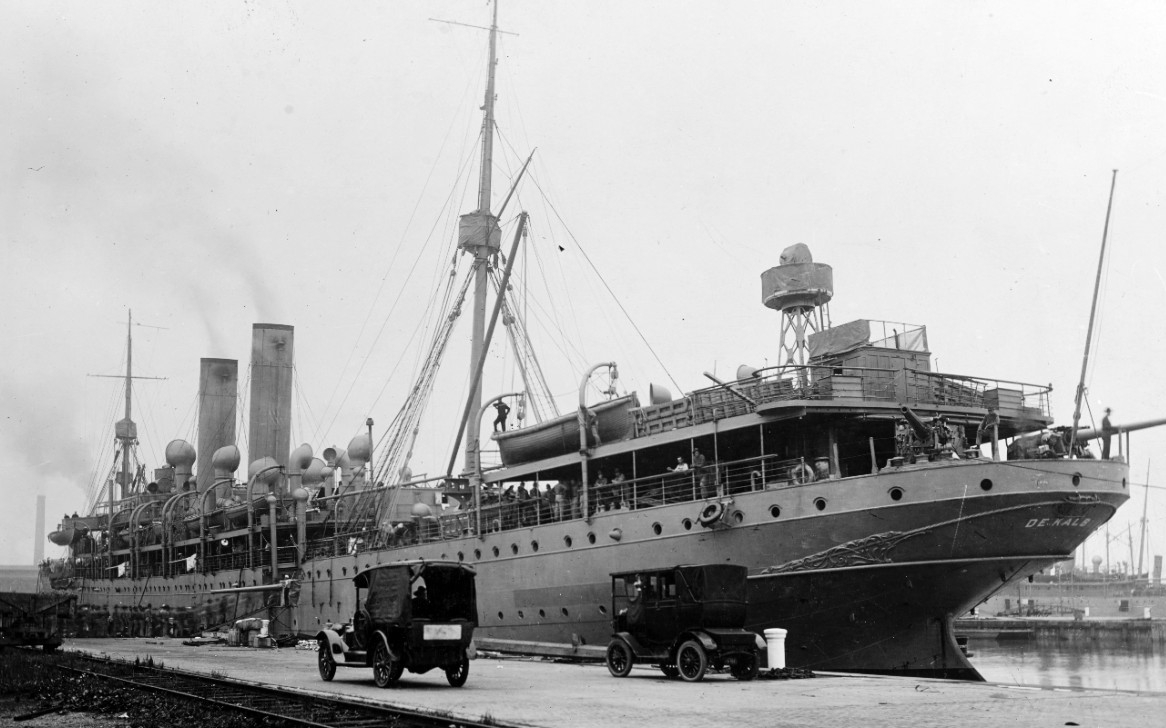
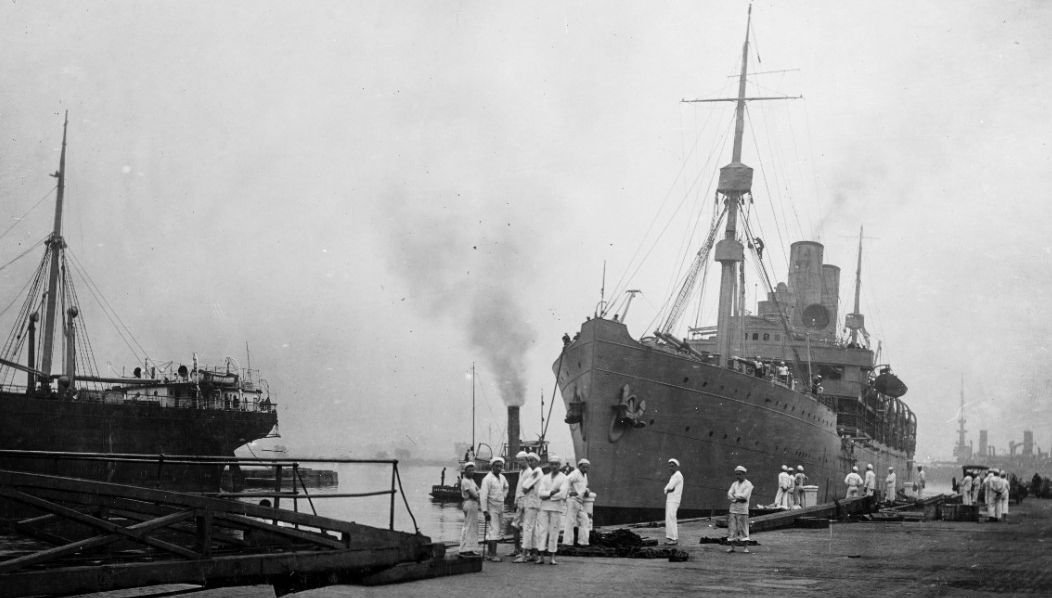
DeKalb departed at 6:17 a.m. on 14 June 1917, as a unit in Convoy Group I (Henderson would be in Group II and Hancock in Group IV). Having gotten underway in a dense fog, she was unable to find the remainder of the convoy off the Ambrose Channel light vessel. Continuing on, she proceeded to Rendezvous No. 1 where she met the others on the 15th and began the transit to France. While en route on 22 June, DeKalb reported seeing two torpedo wakes, with two torpedoes reportedly passing close by U.S. Army Transport (USAT) Havana. The next day the group rendezvoused with destroyers based from Queenstown [Cobh], Ireland (Base No. 6), Cushing (Destroyer No. 55), Jacob Jones (Destroyer No. 61), Conyngham (Destroyer No. 58), Nicholson (Destroyer No. 52), and O’Brien (Destroyer No. 51), and escorted them into St. Nazaire, France (Base No. 8) where they arrived on the 26th. The transport disembarked the marines and unloaded their equipment. While at St. Nazaire, she ran aground on 3 July in the harbor, which prompted the convening of a board of investigation on 5 July, the same day DeKalb departed in company with Henderson and the Army transports Pastores, Tenadores, and Henry R. Mallory. These ships were shepherded to the release point and after parting with her escorts, DeKalb returned to the U.S., arriving at Tompkinsville [Staten Island], N.Y. (Base No. 21) on 17 July. She then entered the yard and underwent repairs to her boilers for 34 days.
DeKalb embarked 821 troops at New York and cleared the port with Group 7 on 7 September 1917. Bound for St. Nazaire, she arrived at Base No. 8 on 19 September. After departing on 29 September, she returned to the U.S. on 9 October. Having embarked 588 marines of the 73rd Machine Gun Company and the Headquarters & Supply Companies, 6th Marine Regiment and 230 sailors at the Philadelphia Navy Yard on 17 October, she got underway that same day to rendezvous at New York. Having joined the convoy, she departed New York in Group 9 on 19 October and arrived at St. Nazaire, on 1 November. She departed St. Nazaire on the 9th and made her return to the Philadelphia Navy Yard where she entered for sixteen days of repairs. DeKalb embarked the 750 men of the 1st Machine Gun Battalion along with the 12th and 26th Replacement Units at the Philadelphia Navy Yard and then having joined Group 14 departed on 14 December. She arrived at St. Nazaire on 28 December and spent the next three days discharging her embarked marines.
DeKalb, having spent New Year’s Day in port, got underway again on 3 January 1918. After her return from France, she entered the yard at Philadelphia and underwent repairs for 21 days. Upon clearing the yard, she embarked 480 Army troops and 300 sailors at the Philadelphia Navy Yard and departing on 19 February 1918, conveyed them in Group 21 to St. Nazaire, which they reached on 4 March, completing her fifth eastward crossing to France.
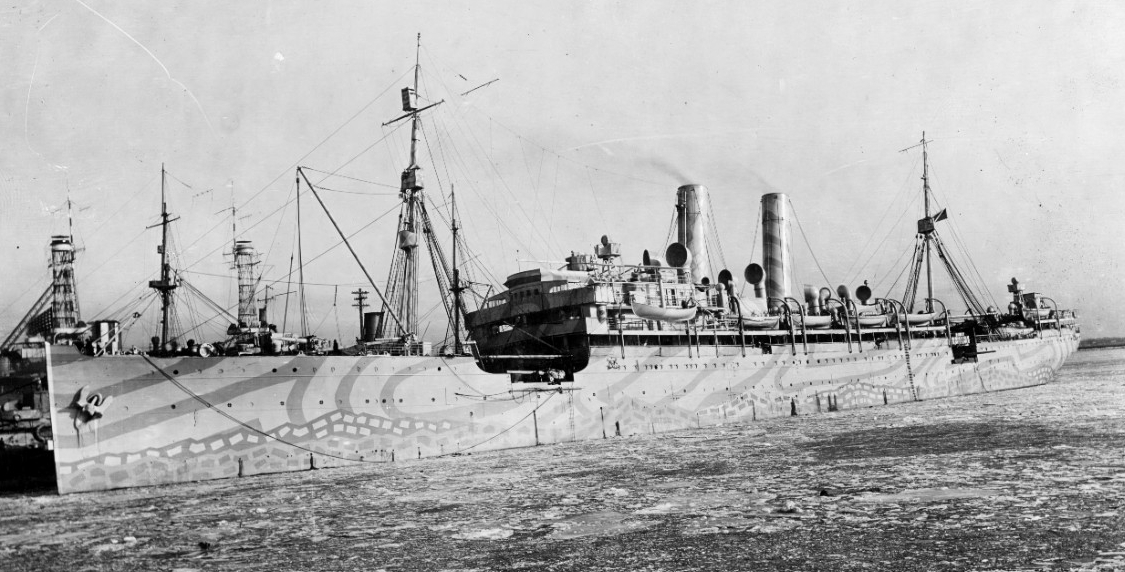
After six days in the French port, she departed on 10 March 1918 and made her return to the U.S. at the Norfolk Navy Yard. The transport embarked 803 troops at Newport News and departed on 30 March in Group 25. Bound for St. Nazaire, she DeKalb arrived at St. Nazaire on 13 April 1918. She departed on 20 April and arrived at the anchorage at Newport News on 1 May. She cleared Newport News on 8 May and standing in with troop transports America (Id. No. 3006) and George Washington (Id. No. 3018), docked at Brest, France (Base No. 7) on 18 May.
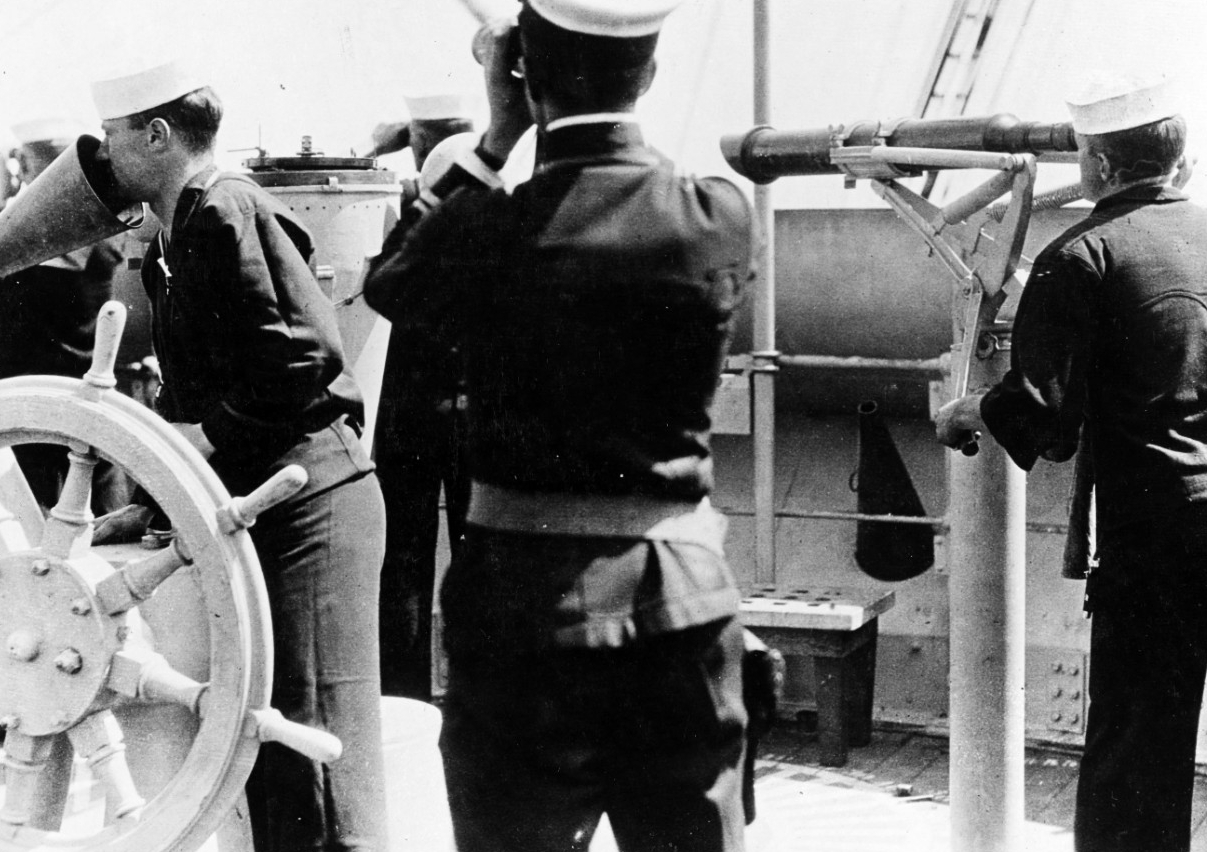
Departing on 21 May 1918, she arrived at Tompkinsville on 31 May and the next day shifted to the 33rd St. Pier, Morse Shipbuilding & Dry Dock Co., Brooklyn, N.Y. where she docked for repairs. Having completed her repairs and coaled, she undocked and shifted to Pier No. 1, at Hoboken N.J., on 13 June. After embarking 769 troops, she cleared Hoboken and crossed the Atlantic in Group 42 to France, standing in at Brest (Base No. 7) on 27 June.
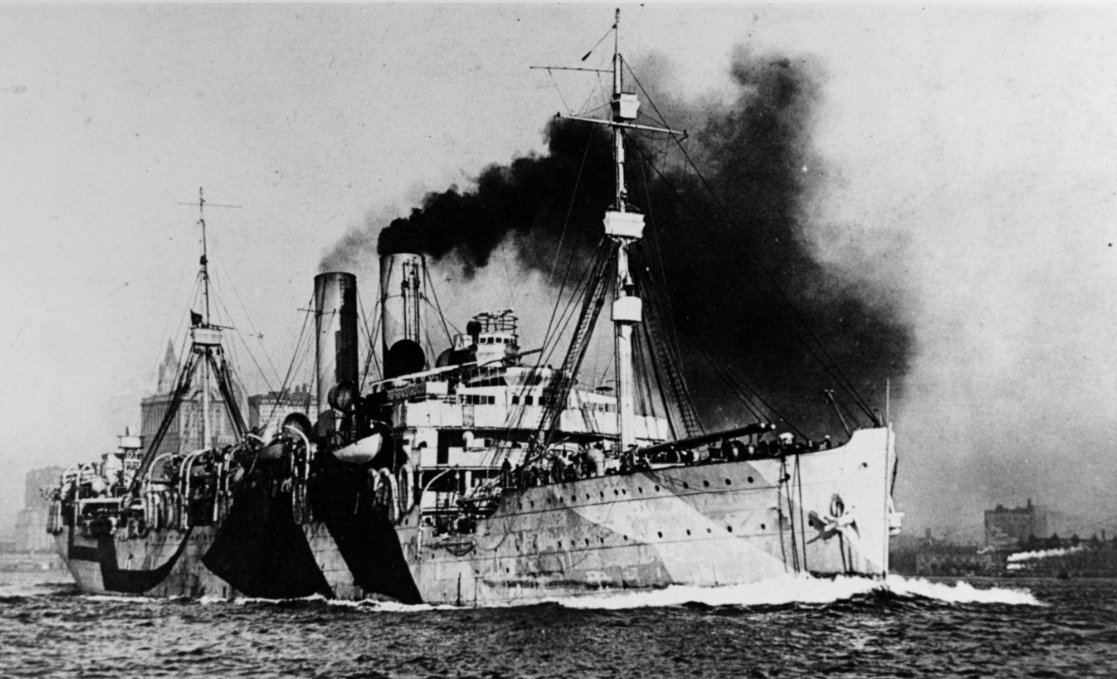
On 30 June 1918, Convoy OR 51, consisting of DeKalb (convoy flagship) and the transports, Covington (Id. No. 1409), George Washington, the Italian transport Dante Alighieri, Lenape (Id. No. 2700), Rijndam (Id. No. 2509), Wilhelmina Id. No. 2168), and Princess Matoika (Id. No. 2290), departed Brest heading westward toward the United States. The escort consisted of Little (Destroyer No. 79) as flagship, Porter (Destroyer No. 59), Reid (Destroyer No. 21), Smith (Destroyer No. 17), Jarvis (Destroyer No. 38), Cummings (Destroyer No. 44), and Conner (Destroyer No. 72). DeKalb was in the center leading the five columns and Covington to port of her and abreast as No. 2 from left. Smith's position was port flank and quarter of convoy, Porter's flank and bow, 1,000 yards ahead; Conner's port bow, Little's 1,500 yards ahead, Cummings' 1,000 yards ahead on starboard bow, Jarvis' 600-1,000 yards off the starboard flank, and finally Reid's 600-1,000 yards off starboard flank and quarter. At 5:20 p.m. on 1 July, the convoy received a submarine warning from the Flag Office at Brest, ordering a course change. Little wired Brest acknowledging the order at 7:30 pm.
Around 9:15 p.m., lookouts on board Covington sighted the wake of a torpedo fired by U-86 (Oberleutnant zur See Helmut Patzig commanding) heading for the ship, 200 yards on the port beam. About ten seconds later, the torpedo hit at the forward engine room bulkhead on the port side, well below the water line, throwing a mass of water and debris high in the air. Shortly after the torpedo hit, gun No. 6, on the port quarter, opened fire on what appeared to be a periscope wake. The ship took a quick list to port of about 20 degrees; then, as the water found its way across the ship, swung back to a five-degree list. The main engines were at once put out of commission. The chief engineer soon reported that the water had completely flooded the ship's two largest compartments, making it necessary to abandon ship. Immediately after the torpedo struck, Smith commenced a depth charge barrage and circled Covington. Meanwhile, as the torpedoed ship lay helpless, liable to be hit again, she was abandoned by the officers and crew in excellent order. Smith took the men on board. A working party of thirty officers and men remained on board Covington, collecting records, charts, and equipment. At 4:00 a.m. on 2 July, a salvage party from Smith boarded Covington. Afterward, Smith headed for Brest at full speed at 5:20 a. m. The tug Concord (Id. No. 773) and the British tugs Revenger and Woonda came up and took Covington under tow. The gradual sinking of the ship, however, finally made progress impossible and the salvage party was taken off at 2:10 p.m.; Covington began to sink rapidly by the stern at 2:30 p.m., and at 2:32 p.m. Covington slipped beneath the surface. Smith, with 743 survivors, proceeded to Brest; and Nicholson with the captain of Covington and the salvage crew, arrived at the same port a few hours later. DeKalb continued westward and arrived at Hoboken on 11 July.
After embarking the Headquarters Company and Squadrons A, B, and C of the First Marine Aviation Force, DeKalb departed Hoboken on 18 July 1918 and arrived at Brest on the 30th. Upon disembarking, the squadrons were redesignated 7, 8, and 9 respectively, and the force proceeded to airdromes between Calais and Dunkirk for operations as the Day Wing, Northern Bombing Group. The transport cleared Brest on 1 August and returned to the U.S., standing in to New York on 12 August. The next day she shifted to Pier 14 at Hoboken where she embarked another contingent of troops bound for France. Having loaded 1,559 troops, she stood down the Hudson and out into the Atlantic on 22 August and reached Brest on 3 September. Departing three days later, she steamed to the Philadelphia Navy Yard, arriving on the 17th. After thirteen days in dry dock for repairs, she cleared the yard on 30 September with 1,593 troops, en route to Brest as part of Convoy Group 70. She reached the French port on 13 October and discharged those embarked with their equipment. After just three days, she was again underway on 16 October, bound for a return to the U.S. and arrived on 25 October. With the signing of the Armistice, hostilities ceased on 11 November. The priority of troop movement for DeKalb now shifted from moving troops eastward to France, to conveying them westward and home. In the next 18 months, DeKalb made 11 such voyages.
DeKalb singled up lines at Hoboken on 19 November 1918 and got underway. Bound for Brest, she arrived on 28 November. Embarking 1,142 troops, she cleared the French coast on 2 December, and arrived, via New York, at Hoboken on 12 December. She underwent ten days of repairs, then on 23 December, again steamed down the Hudson River from the pier at Hoboken bound for France via Great Britain. DeKalb visited Liverpool, England (1-2 January 1919) before standing in to Brest on 4 January. The transport discharged her cargo and embarked 979 troops. She stood out of Brest on 8 January and steamed up the Hudson in to Hoboken on the 21st. Upon her return, she underwent nineteen days of repairs, but was again underway bound for France on 9 February. Arriving at St. Nazaire, via Quiberon, France, on 22 February, she embarked 1,126 troops and departed for the U.S on the 28th. That that same day, DeKalb fouled dredge barges and fishing schooners while in the St. Nazaire Basin. Instead of steaming for Hoboken, DeKalb set a course for Newport News, where she arrived on 12 March. After another thirteen days of repairs at the Norfolk Navy Yard, she cleared the Virginia capes on 25 March and arrived at St. Nazaire on 5 April. Three days later, she was again underway with 1,176 troops embarked. Bound for Newport News, she entered the lower Chesapeake Bay on 19 April and moored the following day to disembark the AEF troops on board. After eight days of maintenance in port, DeKalb again made turns for a return to France. Crossing eastward, she arrived at Bordeaux (Base No. 14) on 10 May.
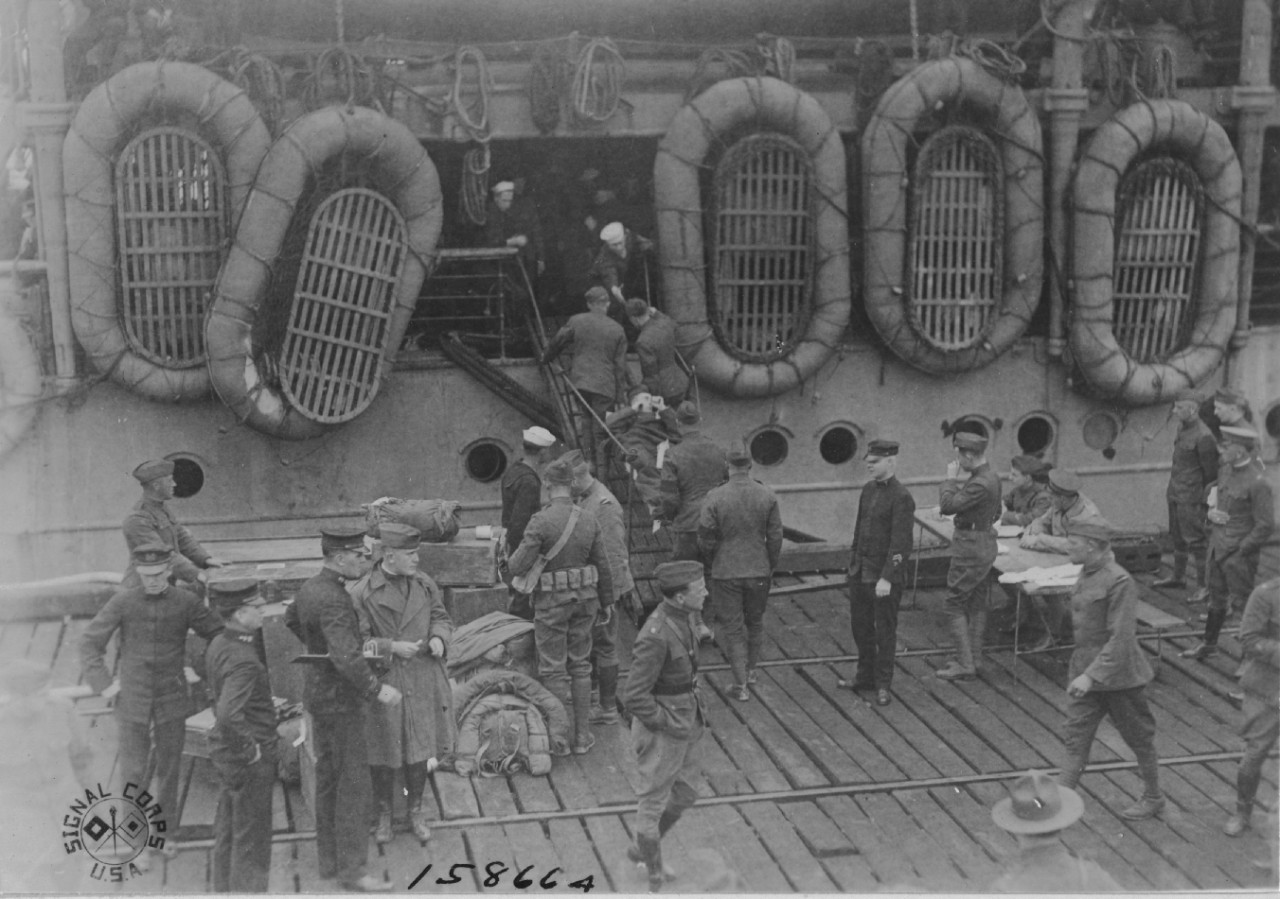
Quickly embarking 1,216 troops, that included the 23rd Ordnance Casual Co., the 311th Field Hospital, and Special Casual Companies Nos. 363 and 563, as well as sick and wounded, she was again underway the next day. En route to Newport News, she arrived on 23 June 1919. After five days in port, she again steamed between Cape Henry and Cape Charles into the Atlantic on 28 June. Setting a course for St. Nazaire, she stood into the harbor on 9 July. In short order, she embarked 1,271 troops and got underway on 11 July, making her return to Newport News, eleven days later, on 22 July. Getting underway on 28 July, DeKalb steamed into the Atlantic for one last transit to France as a troop transport. She arrived at Brest on 8 August. After eighteen days in the French port, DeKalb departed Brest on 26 August 1919 with 764 troops embarked. Standing in to New York on 5 September, she completed her final transatlantic passage as a troop transport. In eight voyages, she carried 20,332 troops back to the U.S. from Europe after the Armistice. The next day, 6 September, she was detached from the Cruiser and Transport Force and transferred to the Commandant, Third Naval District on 1919. Decommissioned on 22 September, DeKalb was transferred to the U.S. Shipping Board for disposal the following day.
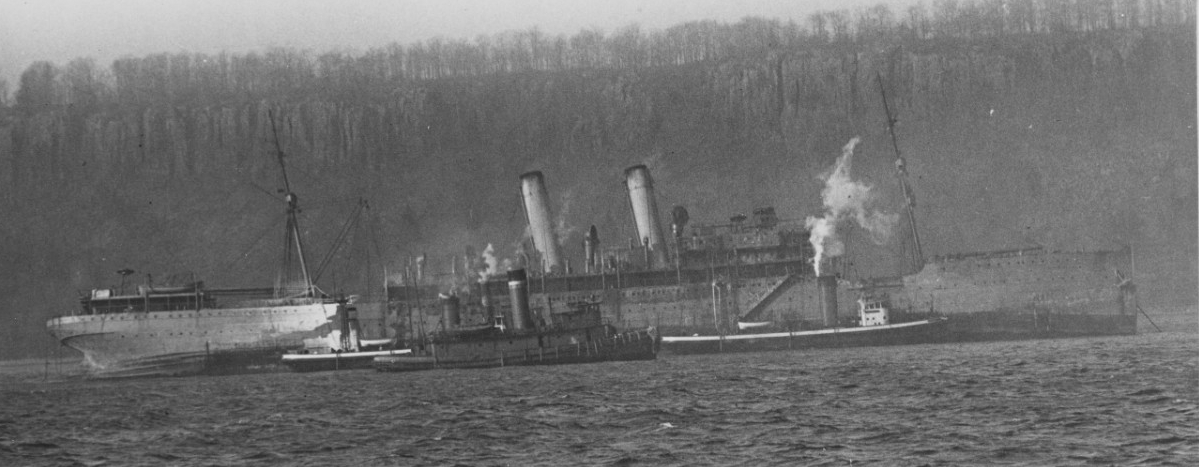
The Daily [U.S. Naval] Aviation News Bulletin of 3 March 1920 told of negotiations “being conducted with a view to obtaining DeKalb…for use as an aviation tender.” Although the author of the Bulletin believed that “this object will be accomplished,” the plan did not come to fruition, and the vessel was returned to civilian control, initially as DeKalb and, after 1920, as Mount Clay. She was operated by the United American Lines on the transatlantic route making her first eastbound voyage from New York to Hamburg, Germany, on 26 December 1920 and her last westbound voyage from Hamburg via Queenstown to New York on 15 October 1925.
Mount Clay was then laid up until 1934, when she was scrapped.
| Commanding Officers | Dates of Command |
| Cmdr. Walter R. Gherardi | 12 May 1917 – 1 August 1918 |
| Lt. Cmdr. William Baggaley | 1 August 1918 – 13 August 1918 |
| Capt. Luther M. Overstreet | 13 August 1918 – 30 October 1918 |
| Capt. Edwin H. Dodd | 30 October 1918 – 22 September 1919 |
Christopher B. Havern Sr.
2 May 2018


